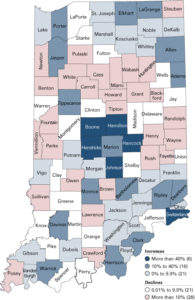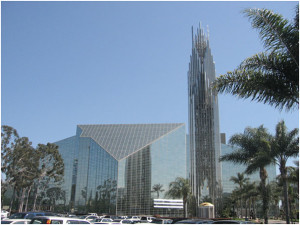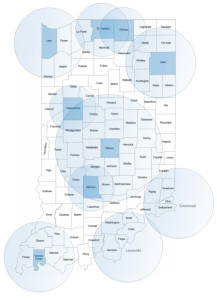Following up on the Pew study that found many states will face declining work age populations in the future, I want to highlight a recent Atlantic article called "The Graying of Rural America." It's a profile of the small Oregon town of Fossil, which is slowly dying as the young people leave and a rump population of older people - median age 56 - begin to pass on. Like the Pew study, this one has implications that weren't fully traced out. There's a lot of urban triumphalism these days, as cities crow about Millennials wanting to live … [Read more...]
The Magic of Microclusters
This post originally appeared on October 27, 2013. If you look at the list of target industries for any given city or state, you usually find several from the same list of five common items: high technology, life sciences (under various names), green tech, advanced manufacturing, logistics. Take a few from this list, and add a legacy industry if there’s one or two where you are already particularly strong, and there you have it. The problem is that everybody and their brother is now claiming to be a tech or startup “hub”, etc. And there’s … [Read more...]
Thoughts On My Neighborhood Post-Ferguson
Some folks asked me to comment on Ferguson, MO. I don't have anything to add to the massive amount that has already been written, but it did get me thinking about my own neighborhood and the racial dynamics that exist in America. I live in a mixed race neighborhood on the North Side of Indianapolis called various names, including South of Broad Ripple (SoBro) and Keystone-Monon. It's a racially diverse area, mostly featuring wood frame 2-3br/1-ba worker cottages built around wartime. It's likely always been working class or starter home … [Read more...]
Suburbs and Sacred Space
This post originally appeared in New Geography on June 7, 2013. Suburbs are often unfairly maligned as lacking the qualities that make cities great. But one place that criticism can be fair is in the area of sacred space. There most certainly is sacred space in the suburbs, but usually less of it than in the city both quantitatively and qualitatively. In fact, the comparative lack of sacred space is one of the distinguishing characteristics of the suburb that makes it “sub” urban, that is, in a sense lesser than the city. Lewis Mumford … [Read more...]
Why Does Louisville Have Better Restaurants Than Indianapolis?
I was briefly back on the homefront earlier this month to check out the now fully opened Big Four Bridge pedestrian path across the Ohio River in Louisville. While there I spent some time in NuLu, a retail and restaurant district centered on Market St. just east of downtown, and had dinner at a French bistro type place called La Coop. This place focuses on what I'd call the basics - it's not trying to be a super high end kind of place. But I'm not going to lie, the undistinguished frites aside, the meal was spectacular front to back, and my … [Read more...]
Columbus: Getting Fit For the Competition Ahead
This is the last of my entries prompted by my recent trip to Columbus. I've noted before that Columbus and Indianapolis are twin cities in many ways, though with some important differences. One of those differences is that the civic discussion in Indianapolis today is heavily driven by the urgency of reversing the decline of Marion County as the city of Indianapolis increasingly loses out demographically and economically to its suburbs. In Columbus, by contrast, I didn't sense nearly the same concern about suburban competition. While again I … [Read more...]
Are States an Anachronism?
This post originally appeared on July 11, 2011. Obviously states aren't going anywhere anytime soon, but a number of folks have suggested that state's aren't just obsolete, they are downright pernicious in their effects on local economies. One principal exponent of this point of view is Richard Longworth, who has written about it extensively in his book "Caught in the Middle" and elsewhere. Here's what he has to say on the topic: In the global era, states are simply too weak and too divided to provide for the welfare of their … [Read more...]
Sunday Night Dinner in Indianapolis
Sunday night dinner in Herron-Morton Place, Indianapolis. This is one of three dinner groups in that neighborhood. Photo by Amanda Reynolds (check out the mirror!)Urban culture varies radically from city to city. Yet to a great extent the culture of the usual suspects type of places tends to get portrayed as normative. In New York, for example, with its tiny apartments, the social life is often in public, in many cases literally on the streets of the city, which pulse with energy. As the ne plus ultra of cities, the street life of New York is … [Read more...]
Rebranding Columbus
This post originally ran on August 15, 2010. Some anachronisms have been left in the piece, so keep the original date in mine. It's no secret I'm a fan of Columbus, Ohio, one of those under the radar cities that's a whole lot better than its external brand image would suggest. That frustrates local civic leaders, who've undertaken a major re-branding effort, as discussed in a recent NYT piece, "There May Be ‘No Better Place,’ but There Is a Better Slogan:" Quick, what do you think about when you hear the words “Columbus, Ohio”? Still … [Read more...]
Why State Economic Development Strategies Should Be Metro-Centric
Globalization, technology, productivity improvements, and the resulting restructuring of the world economy have led to fundamental changes that have destroyed the old paradigms of doing business. Whether these changes are on the whole good or bad, or who or what is responsible for bringing them into being, they simply are. Most cities, regions, and US states have extremely limited leverage in this marketplace and thus to a great extent are market takers more than market makers. They have to adapt to new realities, but a lack of willingness to … [Read more...]
- « Previous Page
- 1
- 2
- 3
- 4
- …
- 6
- Next Page »



